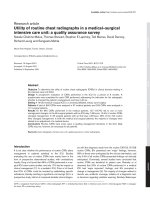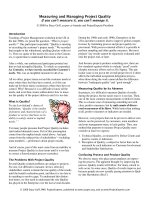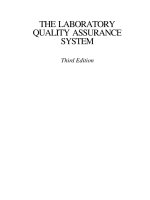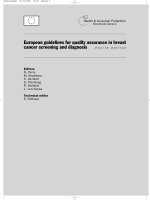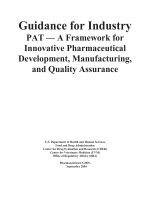Lesson 06 Project Quality Assurance Managemnet
Bạn đang xem bản rút gọn của tài liệu. Xem và tải ngay bản đầy đủ của tài liệu tại đây (694.2 KB, 87 trang )
Lesson 6:
Developing Project Plan
(Project Quality Management)
2
Learning Objectives
Understand the importance of project quality
management and services.
Define project quality management and understand how
quality relates to various aspects of projects.
Describe quality planning and its relationship to project
scope management.
Discuss the importance of quality assurance.
List the three outputs of the quality control process.
3
Learning Objectives
Understand the tools and techniques for quality control,
such as Pareto analysis, statistical sampling, Six Sigma,
quality control charts, and testing.
Summarize the contributions of noteworthy quality
experts to modern quality management.
Describe how leadership, cost, organizational influences,
expectations, cultural differences, standards, and maturity
models relate to improving quality in information
technology projects.
Discuss how software can assist in project quality
management.
4
What Is Quality?
The International Organization for Standardization
(ISO) defines quality as “the degree to which a set of
inherent characteristics fulfils requirements”
(ISO9000:2000).
Other experts define quality based on:
Conformance to requirements: The project’s
processes and products meet written specifications.
Fitness for use: A product can be used as it was
intended.
5
What Is Project Quality
Management?
Project quality management ensures that the project will
satisfy the needs for which it was undertaken.
Processes include:
Quality planning: Identifying which quality standards are
relevant to the project and how to satisfy them.
Quality assurance: Periodically evaluating overall project
performance to ensure the project will satisfy the relevant
quality standards.
Quality control: Monitoring specific project results to
ensure that they comply with the relevant quality standards.
6
Quality Planning
Implies the ability to anticipate situations and prepare
actions to bring about the desired outcome.
Important to prevent defects by:
Selecting proper materials.
Training and indoctrinating people in quality.
Planning a process that ensures the appropriate
outcome.
7
Design of Experiments
Design of experiments is a quality planning technique
that helps identify which variables have the most
influence on the overall outcome of a process.
Also applies to project management issues, such as cost
and schedule trade-offs.
Involves documenting important factors that directly
contribute to meeting customer requirements.
8
Scope Aspects of Projects
Functionality is the degree to which a system performs its
intended function.
Features are the system’s special characteristics that appeal to
users.
System outputs are the screens and reports the system
generates.
Performance addresses how well a product or service performs
the customer’s intended use.
Reliability is the ability of a product or service to perform as
expected under normal conditions.
Maintainability addresses the ease of performing maintenance
on a product.
9
Who’s Responsible for the Quality
of Projects?
Project managers are ultimately responsible for quality
management on their projects.
Several organizations and references can help project
managers and their teams understand quality.
International Organization for Standardization
(www.iso.org)
IEE (www.iee.org)
10
Quality Assurance
Quality assurance includes all the activities related to
satisfying the relevant quality standards for a project.
Another goal of quality assurance is continuous quality
improvement.
Benchmarking generates ideas for quality improvements by
comparing specific project practices or product
characteristics to those of other projects or products within or
outside the performing organization.
A quality audit is a structured review of specific quality
management activities that help identify lessons learned that
could improve performance on current or future projects.
11
Table 6-1. Table of Contents for a
Quality Assurance Plan*
*U.S. Department of Energy
1.0 Draft Quality Assurance Plan
1.1 Introduction
1.2 Purpose
1.3 Policy Statement
1.4 Scope
2.0 Management
2.1 Organizational Structure
2.2 Roles and Responsibilities
2.2.1 Technical Monitor/Senior
Management
2.2.2 Task Leader
2.2.3 Quality Assurance Team
2.2.4 Technical Staff
3.0 Required Documentation
4.0 Quality Assurance Procedures
4.1 Walkthrough Procedure
4.2 Review Process
4.2.1 Review Procedures
4.3 Audit Process
4.3.1 Audit Procedures
4.4 Evaluation Process
4.5 Process Improvement
5.0 Problem Reporting Procedures
5.1 Noncompliance Reporting
Procedures
6.0 Quality Assurance Metrics
Appendix
Quality Assurance Checklist Forms
12
Quality Control
The main outputs of quality control are:
Acceptance decisions
Rework
Process adjustments
Some tools and techniques include:
Pareto analysis
Statistical sampling
Six Sigma
Quality control charts
13
Pareto Analysis
Pareto analysis involves identifying the vital few
contributors that account for the most quality problems
in a system.
Also called the 80-20 rule, meaning that 80 percent of
problems are often due to 20 percent of the causes.
Pareto diagrams are histograms, or column charts
representing a frequency distribution, that help identify
and prioritize problem areas.
14
Figure 4-1. Sample Pareto Diagram
15
Statistical Sampling and Standard
Deviation
Statistical sampling involves choosing part of a
population of interest for inspection.
The size of a sample depends on how representative
you want the sample to be.
Sample size formula:
Sample size = .25 X (certainty factor/acceptable error)
2
Be sure to consult with an expert when using
statistical analysis.
16
Six Sigma
Six Sigma is “a comprehensive and flexible system for
achieving, sustaining, and maximizing business
success. Six Sigma is uniquely driven by close
understanding of customer needs, disciplined use of
facts, data, and statistical analysis, and diligent
attention to managing, improving, and reinventing
business processes.”*
*Pande, Peter S., Robert P. Neuman, and Roland R. Cavanagh, The
Six Sigma Way, New York: McGraw-Hill, 2000, p. xi.
17
Basic Information on Six Sigma
The target for perfection is the achievement of no more
than 3.4 defects per million opportunities.
The principles can apply to a wide variety of processes.
Six Sigma projects normally follow a five-phase
improvement process called DMAIC.
18
DMAIC
DMAIC is a systematic, closed-loop process for continued
improvement that is scientific and fact based.
DMAIC stands for:
Define: Define the problem/opportunity, process, and
customer requirements.
Measure: Define measures, then collect, compile, and display
data.
Analyze: Scrutinize process details to find improvement
opportunities.
Improve: Generate solutions and ideas for improving the
problem.
Control: Track and verify the stability of the improvements
and the predictability of the solution.
19
How is Six Sigma Quality
Control Unique?
It requires an organization-wide commitment.
Training follows the “Best” system.
Six Sigma organizations have the ability and
willingness to adopt contrary objectives, such as
reducing errors and getting things done faster.
It is an operating philosophy that is customer focused
and strives to drive out waste, raise levels of quality,
and improve financial performance at breakthrough
levels.
20
Six Sigma Projects Use
Project Management
The training for Six Sigma includes many project
management concepts, tools, and techniques.
For example, Six Sigma projects often use business
cases, project charters, schedules, budgets, and so on.
Six Sigma projects are done in teams; the project
manager is often called the team leader, and the
sponsor is called the champion.
21
Six Sigma and Statistics
The term sigma means standard deviation.
Standard deviation measures how much variation
exists in a distribution of data.
Standard deviation is a key factor in determining the
acceptable number of defective units found in a
population.
Six Sigma projects strive for no more than 3.4 defects
per million opportunities, yet this number is confusing
to many statisticians.
22
Six Sigma Uses a Conversion Table
Using a normal curve, if a process is at six sigma, there
would be no more than two defective units per billion
produced.
Six Sigma uses a scoring system that accounts for time, an
important factor in determining process variations.
Yield represents the number of units handled correctly
through the process steps.
A defect is any instance where the product or service fails
to meet customer requirements.
There can be several opportunities to have a defect.
23
Figure 6-2. Normal Distribution and
Standard Deviation
24
Table 6-3. Sigma and Defective Units
25
Table 6-4: Six Sigma Conversion
Table
The Six Sigma convention for determining defects is based on the above
conversion table. It accounts for a 1.5 sigma shift to measure the number of
defects per million opportunities instead of the number of defects
per unit.
